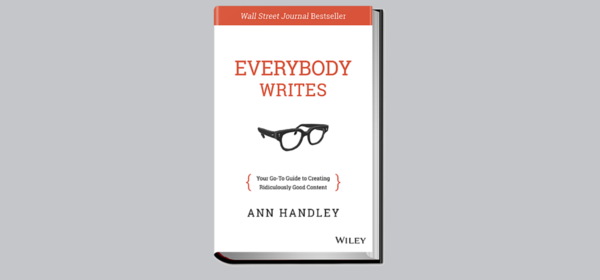
Posted By Mary Pavlu on July 16, 2015
You’re either a good writer or you’re not. That’s what most of us have been taught - that writing well is a gift - and you either have it, or you don’t.
Quite frankly, that’s crap, according to Ann Handley, Chief Content Officer at MarketingProfs. In her book “Everybody Writes,” the marketing expert challenges everything we’ve ever known about writing, explaining that “writing well is part habit, part knowledge of some fundamental rules, and part giving a damn.”
What’s more is that when it comes to business, we need to write, and we need to write well. That’s because good, clear content isn’t just for blogs and emails anymore - it has expanded to our endless stream of social channels and is often posted on-the-go.
For anyone like me (wanting to strengthen their writing without really knowing how), reading this book was like finding the holy grail of writing. Ann Handley proves that we can all perfect our writing, regardless of experience level. I’m already noticing a difference in how I think when I hit the keyboard. I can tell this book will be a go-to resource of mine for years to come.
So, how do you produce good content, even if you’re not totally confident in your own expertise? Right off the bat, the book outlines some great, simple tips for stepping up your writing. Here are three of my favorites. You may be be surprised at how simple, but effective these three steps can be.
How to Write Better (And How to Hate Writing Less)
1. The first step is to make writing a habit.
Handley quotes Beth Dunn, a user-experience editor for HubSpot, and the sentiment just nails it:
“Write like crap if you have to. But write every day. Keep the streak alive.”
Before you start groaning at the thought of putting pen to paper everyday - remember that you probably already do write everyday. Writing includes emails, Facebook posts, tweets and blog comments. The point is to keep in mind to write in a way that reflects well on yourself and your company. Handley compares it to showing up at the gym - a bit awkward, and sometimes painful, but keeping at it will provide the best results.
2. Start with ‘Dear Mom’ (really!)
This is a tip writer John McPhee credited in a piece in the New Yorker, as a way to avoid writer's block - or a fear of a blank page. As a business writer, you can adapt that approach by thinking of a customer, instead of a nameless, faceless reader. By picturing a familiar reader, it will help to relax your tone and sound more natural.
3. Keep it simple - but not simplistic.
Many of the topics we write about are complex and not easily understood by the average reader. A good writer deconstructs the complex and reproduces it in clear and accessible words. Ask yourself, can I clearly describe my point in fewer words? Would a graphic or video convey my point more clearly?
Take it from the first requirement of The Economist’s Style Guide - “The first requirement of The Economist is that it should be readily understandable. Clarity of writing usually follows clarity of thought. So think what you want to say, then say it as simply as possible.”
“Everybody Writes” isn’t just for business and marketing professionals. The book offers great tips for anyone looking to improve their writing, regardless of experience level. What’s more is that “Everybody Writes” isn’t just a one time read - it’s a great resource to refer back to for anyone writing a book or blog - or even a Tweet. Fair warning, you’ll likely be itching to get writing yourself after giving the book a read.


